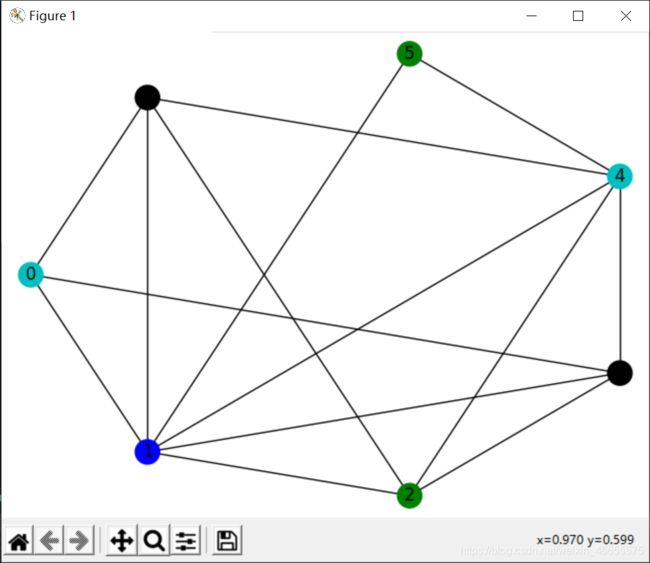基于启发式策略的图着色问题
目录
- 问题背景
- 解决思路
- 代码实现
- 说明
问题背景
图着色问题(Graph Coloring Problem, GCP) 又称着色问题,是最著名的NP-完全问题之一。道路着色问题(Road Coloring Problem)是图论中最著名的猜想之一。
数学定义:给定一个无向图G=(V, E),其中V为顶点集合,E为边集合,图着色问题即为将V分为K个颜色组,每个组形成一个独立集,即其中没有相邻的顶点。其优化版本是希望获得最小的K值。
人类已经用计算机证明,一切平面可着色图,都可用4种颜色以内进行涂色。本实验不作任何理论证明,只提供一个可以解决问题的思路和代码实现方式。
解决思路
- 对于解决如何用K种颜色完成涂色过程,我采用回溯法遍历搜索。如果能够在搜索和回溯过程中找到一个解,则该问题解决;如果遍历完所有的情况,则可认为该问题无解。
- 对于解决如何找到K的最小值,可以将K在一定范围内依次尝试。如果能找到用m种颜色成功,而用m - 1种颜色失败,则可以认为 K = m。
- 对于1中的回溯法遍历搜索,如果采取无信息搜索,效率低下,故引入启发式策略,分别为:(1)当前状态下,值域最小的顶点优先被涂色;(2)值域大小相同者,度最大者优先。引入该方法,解决复杂的图着色问题,效率会大大提高。
代码实现
import networkx as nx
import matplotlib.pyplot as plt
import numpy as np
import functools
# 邻接矩阵
Matrix = np.array([
[0, 1, 0, 1, 0, 0, 1],
[1, 0, 1, 1, 1, 1, 1],
[0, 1, 0, 1, 1, 0, 1],
[1 ,1 ,1, 0, 1, 0, 0],
[0 ,1 ,1, 1, 0, 1, 1],
[0, 1, 0, 0, 1, 0, 0],
[1, 1, 1, 0, 1, 0, 0],])
G = nx.Graph(Matrix) # 用邻接矩阵建图
color_list = ['b','c','g','k','m', 'r','y'] # 颜色列表
max_color_num = 4 # 允许使用颜色的最大值
num = len(Matrix) # 顶点个数
class ColorProblem(object):
'''
有策略搜索 + 回溯
'''
def __init__(self):
self.path = []
self.visited = set()
self.color = 'w' * num
self.colored_num = 0
self.ok = False
for i in range(num):
if self.color[i] != 'w':
self.colored_num += 1
def cur_is_legle(self):
'''
判断当前状态是否合法
'''
for vi in range(num):
for vj in range(num):
if vi != vj and Matrix[vi][vj] and self.color[vi] != 'w' and self.color[vi] == self.color[vj]:
return False
return True
def is_legle(self,color_s:str):
'''
判断某一状态是否合法
'''
for vi in range(num):
for vj in range(num):
if vi != vj and Matrix[vi][vj] and color_s[vi] != 'w' and color_s[vi] == color_s[vj]:
return False
return True
def get_next(self):
'''
获得涂色方法,[i, j]表示将节点i涂为颜色j
'''
next = []
for i in range(num):
if self.color[i] != 'w':
continue
for j in range(max_color_num):
next_state = self.color
temp = list(next_state)
temp[i] = color_list[j]
next_state = ''.join(temp)
if next_state in self.visited or not self.is_legle(next_state):
continue
next.append((i,j))
def cmp(x,y):
'''
比较函数,其比较策略如下:
1.值域最小者优先
2.值域大小相同者,度最大者优先
'''
set_x = set() # 储存邻点的颜色,颜色多者值域小
set_y = set()
for i in range(num):
if Matrix[x[0]][i] == 0:
continue
if self.color[i] == 'w':
continue
set_x.add(self.color[i])
for i in range(num):
if Matrix[x[0]][i] == 0:
continue
if self.color[i] == 'w':
continue
set_y.add(self.color[i])
if len(set_x) > len(set_y): # 值域小优先
return 1
if len(set_x) < len(set_y):
return -1
if G.degree(x[0]) > G.degree(y[0]): # 度启发式
return 1
if G.degree(x[0]) < G.degree(y[0]):
return -1
return 0
# 根据上述策略,对涂色可能的策略表进行排序
next.sort(key=functools.cmp_to_key(cmp),reverse=True)
if len(next):
return next[0]
return None
def go_next(self):
'''
涂色以转化为下一状态
'''
next = self.get_next()
if next == None:
return False
next_state = list(self.color)
next_state[next[0]] = color_list[next[1]]
self.color = ''.join(next_state)
self.path.append(next)
self.visited.add(self.color)
self.colored_num+=1
self.display()
if not self.cur_is_legle():
return False
if self.colored_num == num:
self.ok = True
return True
def go_back(self):
'''
回溯
'''
back = self.path.pop()
self.colored_num -= 1
temp = list(self.color)
temp[back[0]] = 'w'
self.color = ''.join(temp)
self.display()
def start_color(self):
'''
开始涂色
'''
if self.go_next() == False:
return
while self.color != 'w' * num and self.ok == False:
if not self.go_next():
self.go_back()
if self.ok:
self.display()
print(self.color)
return
print("There's no legal solution!")
def display(self):
plt.clf()
nx.draw_shell(G, with_labels=True, node_color=list(self.color))
plt.pause(0.02)
if __name__ == '__main__':
plt.figure()
plt.ion()
p = ColorProblem()
p.start_color()
plt.ioff()
plt.show()
说明
- 本代码采取的是带启发式的回朔法,类似于贪婪算法+深度优先的策略。可以尝试改变
max_color_num的值确定最小的颜色种类。 - 本算法完备性好,理论上是比无信息回溯更加高效的。但是其高效与否,有待于更大更丰富的、不同规模的测试集去验证。如果感兴趣,可以用如下最初不带启发式策略的方法进行对比。(但是注意要调整动画效果,取消暂停。)代码也贴上:
import networkx as nx
import matplotlib.pyplot as plt
import numpy as np
import functools
# 邻接矩阵
Matrix = np.array([
[0, 1, 0, 1, 0, 0, 1],
[1, 0, 1, 1, 1, 1, 1],
[0, 1, 0, 1, 1, 0, 1],
[1 ,1 ,1, 0, 1, 0, 0],
[0 ,1 ,1, 1, 0, 1, 1],
[0, 1, 0, 0, 1, 0, 0],
[1, 1, 1, 0, 1, 0, 0],])
G = nx.Graph(Matrix) # 用邻接矩阵建图
color_list = ['b','c','g','k','m', 'r','y'] # 颜色列表
max_color_num = 4 # 允许使用颜色的最大值
num = len(Matrix) # 顶点个数
class ColorProblem(object):
'''
无启发式,暴力回溯
'''
def __init__(self):
self.path = []
self.visited = set()
self.color = 'w' * num
self.colored_num = 0
self.ok = False
# 用白色将各个顶点初始化
for i in range(num):
if self.color[i] != 'w':
self.colored_num += 1
def is_legle(self):
'''
判断合法性
'''
for vi in range(num):
for vj in range(num):
if vi != vj and Matrix[vi][vj] and self.color[vi] != 'w' and self.color[vi] == self.color[vj]:
return False
return True
def get_next(self):
'''
获得涂色方法,[i, j]表示将节点i涂为颜色j
'''
next = []
for i in range(num):
if self.color[i] != 'w':
continue
for j in range(max_color_num):
next_state = self.color
temp = list(next_state)
temp[i] = color_list[j]
next_state = ''.join(temp)
if next_state not in self.visited:
next.append((i,j))
'''
此处可以优化
'''
if len(next):
return next[0]
return None
def go_next(self):
'''
涂色,变为下一状态
'''
next = self.get_next()
if next == None:
return False
next_state = list(self.color)
next_state[next[0]] = color_list[next[1]]
self.color = ''.join(next_state)
self.path.append(next)
self.visited.add(self.color)
self.colored_num+=1
self.display()
if not self.is_legle():
return False
if self.colored_num == num:
self.ok = True
return True
def go_back(self):
'''
回溯
'''
back = self.path.pop()
self.colored_num -= 1
temp = list(self.color)
temp[back[0]] = 'w'
self.color = ''.join(temp)
self.display()
def start_color(self):
'''
开始涂色
'''
if self.go_next() == False:
return
while self.color != 'w' * num and self.ok == False:
if not self.go_next():
self.go_back()
if self.ok:
self.display()
print(self.color)
return
print("There's no legal solution!")
def display(self):
plt.clf()
nx.draw_shell(G, with_labels=True, node_color=list(self.color))
plt.pause(0.02)
if __name__ == '__main__':
plt.figure()
plt.ion()
p = ColorProblem()
p.start_color()
plt.ioff()
plt.show()
